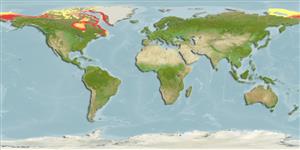Environment: milieu / climate zone / depth range / distribution range
Ökologie
seewasser; brackwasser demersal; tiefenbereich 0 - 280 m (Ref. 117245). Polar; 83°N - 49°N, 142°E - 45°W (Ref. 117245)
Arctic: to James Bay and Straits of Belle Isle in Canada and Greenland.
Size / Gewicht / Alter
Maturity: Lm ? range ? - ? cm
Max length : 22.0 cm TL Männchen/unbestimmt; (Ref. 7251)
Rückenflossenstacheln (insgesamt): 8 - 9; Rückenflossenweichstrahlen (insgesamt): 14-17; Afterflossenstacheln 0; Afterflossenweichstrahlen: 11 - 13. Caudal fin rounded. Upper parts blackish-brown (paler in females), flanks with dark cross-bands (fainter in males, which have dark bordered white or silvery irregular spots under pectoral fins and above anal fin); breast and belly with dark spots in males and broad white band on reddish orange from pelvic base to anus; lower lip spotted in males (dark in females); pelvic fins with 2-3 dark cross-bands; pectoral rays blackish-brown in males, the membrane with 4-5 transverse rows of translucent spots (some light bands in females); white blotches or stripes on dorsal and anal fins (Ref. 4698).
Found on rocky bottoms among algae (Ref. 4698). Benthic (Ref. 58426). Feeds on small benthic amphipods (Ref. 4698).
Life cycle and mating behavior
Geschlechtsreife | Fortpflanzung | Ablaichen | Eier | Fecundity | Larven
Robins, C.R. and G.C. Ray, 1986. A field guide to Atlantic coast fishes of North America. Houghton Mifflin Company, Boston, U.S.A. 354 p. (Ref. 7251)
IUCN Rote Liste Status (Ref. 130435)
Bedrohung für Menschen
Harmless
Nutzung durch Menschen
Mehr Information
ReferenzenAquakulturAquakultur ProfilZuchtlinienGenetikElectrophoresesVererbbarkeitKrankheitenVerarbeitungNutrientsMass conversion
PartnerBilderStamps, Coins Misc.LauteCiguateraGeschwindigkeitSchwimmstilKiemenoberflächeOtolithsGehirngrößeSehfähigkeit
Tools
Zusatzinformationen
Download XML
Internet Quellen
Estimates based on models
Preferred temperature (Ref.
123201): 0.1 - 7.8, mean 1.1 °C (based on 532 cells).
Phylogenetic diversity index (Ref.
82804): PD
50 = 0.5000 [Uniqueness, from 0.5 = low to 2.0 = high].
Bayesian length-weight: a=0.00676 (0.00300 - 0.01523), b=3.17 (2.98 - 3.36), in cm total length, based on LWR estimates for this (Sub)family-body shape (Ref.
93245).
Trophic level (Ref.
69278): 3.4 ±0.52 se; based on food items.
Widerstandsfähigkeit (Ref.
120179): mittel, Verdopplung der Population dauert 1,4 - 4,4 Jahre. (Preliminary K or Fecundity.).
Fishing Vulnerability (Ref.
59153): Low vulnerability (12 of 100).
